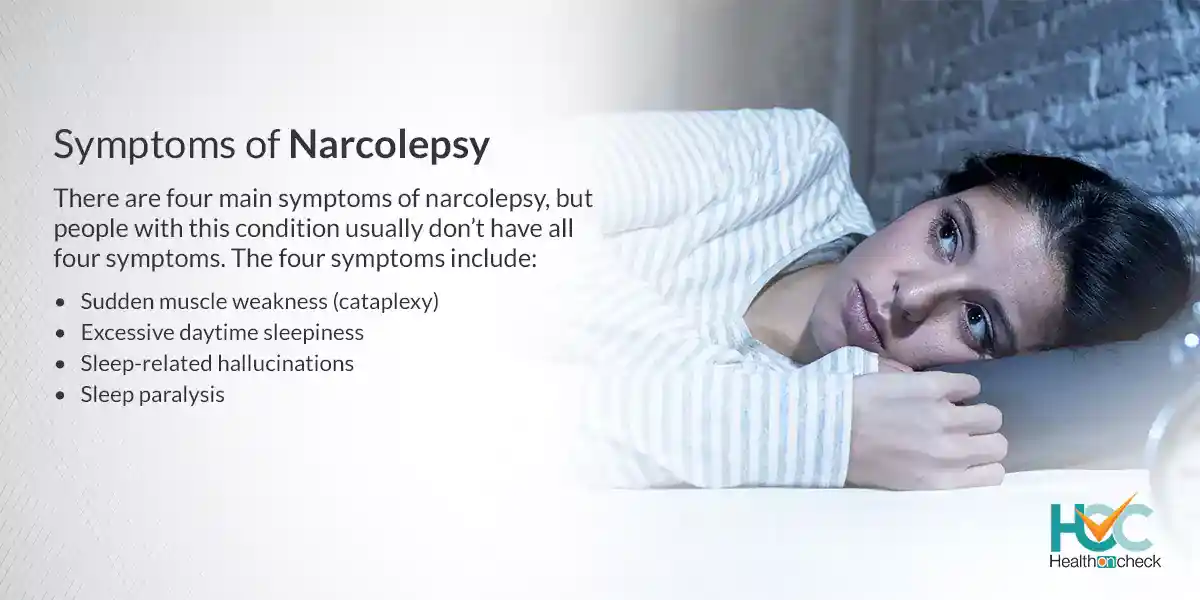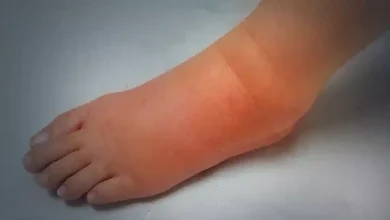All about Narcolepsy

What is Narcolepsy?
Narcolepsy is a sleep-related complication causing an abnormal urge to sleep suddenly during the daytime that is quite impossible to resist. Even though this disorder isn’t very common, it’s widely known because of its symptoms and how they occur. Narcolepsy is a life-long condition with no cure. Although, medicines and lifestyle changes can be helpful to manage and control the symptoms. Support from close ones such as family, and friends, can help people deal with the disorder.
What are the Types of Narcolepsy?
The types of Narcolepsy include:
Type 1 Narcolepsy: It is the most common type of narcolepsy and is easier to diagnose. Type 1 is also called narcolepsy with cataplexy and this term refers to temporary and sudden muscle weakness that might leave one immobilised. Anger, excitement, or laughter might cause you to lose muscle control. You may slur or omit your speech. These episodes might last some seconds or a couple of minutes. You will be awake and aware of what’s going around.
Type 2 Narcolepsy: It was once known as narcolepsy without cataplexy, which means you don’t lose muscle control. Other than that, your symptoms are more or less similar to those of type 1 narcolepsy.
Secondary Narcolepsy: It is the rarest type of narcolepsy which may occur after an injury to a deep part of your brain known as the hypothalamus whose function is regulating your sleep. A brain tumour, multiple sclerosis, or brain inflammation called encephalitis might also cause Secondary narcolepsy. You may experience the common symptoms of narcolepsy including fragmented sleep at night but you might also have the urge to sleep a lot — above 10 hours per night.
What are the Symptoms of Narcolepsy?

There are four main symptoms of narcolepsy, but people with this condition usually don’t have all four symptoms. The four symptoms include:
Excessive daytime sleepiness: Everyone with narcolepsy experiences this symptom and people with narcolepsy and experts on the condition usually call these “sleep attacks.”
Sudden muscle weakness (cataplexy): It can have moderate effects, which affect one side of your body or only light muscle weakness.
Sleep-related hallucinations: People with narcolepsy might experience hallucinations while sleeping or exactly before waking up.
Sleep paralysis: During this symptom you will wake up — sometimes completely, but not always and you may find yourself not able to move while being aware that you are sleeping. Most people experience sleep paralysis once in a while even if they don’t have narcolepsy.
What are the Causes of Narcolepsy?
The exact cause of narcolepsy is not clear however, people with type 1 narcolepsy experience low levels of hypocretin also known as orexin. Hypocretin is a chemical in the brain that helps to control being awake and while entering REM sleep.
People who experience cataplexy have low levels of hypocretin but what exactly leads to the loss of hypocretin-producing cells in the brain isn’t clear. However, researchers doubt it might be because of an autoimmune reaction. An autoimmune reaction is when the body’s immune system starts to attack and destroy its own cells.
It’s quite possible that genetics also plays a role in the development of narcolepsy. But the risk of a parent passing this condition to their child is quite low which is only about 1% to 2%.
Studies have also indicated that in some instances narcolepsy might be connected to exposure to the swine flu (H1N1 flu) virus. It also may be linked to a specific type of the H1N1 vaccine.
What are the Risk Factors of Narcolepsy?
The risk factors of narcolepsy include:
Age: Narcolepsy usually starts between ages 10 and 30.
Family history: The risk of developing narcolepsy is 20 to 40 times higher if you have a close family member with this condition.
What are the Complications of Narcolepsy?
The complications of narcolepsy might include:
Public misconception of the condition: Narcolepsy might cause issues in your work or your personal life and your performance at work or school might be affected. Others might see people with narcolepsy as lethargic or lazy.
Effects on intimate relationships: Cataplexy might be triggered due to intense feelings, like anger or joy which might result in people with narcolepsy getting withdrawn from emotional interactions.
Physical harm: Suddenly falling asleep might cause injuries and you have an increased risk of a car accident in case you fall asleep while driving. Your risk of cuts and burns also increases if you fall asleep while doing chores such as cooking.
Obesity: People with narcolepsy have an increased risk of getting overweight. Sometimes weight increases rapidly when sleepiness symptoms begin.
How Narcolepsy is Diagnosed?
A doctor can detect narcolepsy depending on your symptoms. Although, the symptoms of narcolepsy can be similar to various other brain- and sleep-related disorders. Due to this, specialized diagnostic tests are the only way to diagnose narcolepsy.
Before performing the main tests for narcolepsy, your doctor will first ensure that you’re getting enough sleep and it generally includes simple tracking methods for your sleep-wake patterns, like actigraphy. It usually uses a watch-like device that you have to wear on your wrist for tracking movement patterns like when you’re sleeping and when you are waking up and moving around while awake.
A sleep specialist will diagnose narcolepsy and its severity depending on:
Your sleep history: Your doctor will get information about your detailed sleep history to diagnose your condition you need to fill out the Epworth Sleepiness Scale which uses short questions to measure the degree of your sleepiness. You need to answer how likely it is that you will sleep in specific periods, like taking rest after lunch.
Your sleep records: You might be asked to pen down your sleep pattern for one to two weeks which permits your doctor to compare how your sleep pattern might be connected to how alert you feel.
Your doctor might also ask you to wear an actigraph which you need to wear like a watch. It measures the periods of activity and rest and gives an indirect measure of how and when you sleep.
Tests to diagnose narcolepsy usually include:
A sleep study, called polysomnography: This test helps to signal while you are asleep by using flat metal discs known as electrodes attached to your scalp. To perform this test, you need to spend a night at a medical facility. The test helps to measure your heart rate, brain waves, and breathing along with recording your leg and eye movements.
Multiple sleep latency test: It measures the time it takes you to fall asleep during the day. You have to take four or five naps at a sleep center. Each nap required to be two hours apart. Your sleep patterns will be observed by a specialist and people with this disorder will fall asleep easily and enter into rapid eye movement (REM) sleep rapidly.
Genetic tests and a lumbar puncture, called a spinal tap: In some instances, a genetic test might be carried out to see if you’re at risk of type 1 narcolepsy. If so, your sleep specialist might prescribe a lumbar puncture to determine the level of hypocretin in your spinal fluid.
These tests are also helpful in ruling out other possible factors of your symptoms. Excessive daytime sleepiness might also occur due to sleep deprivation, using sedating medicines, and sleep apnea.
What are the Treatment Options Available for Narcolepsy?
Narcolepsy is not curable but its symptoms can be managed. Treatments generally begin with medications, but changes to your daily routine and lifestyle are also helpful. In general, narcolepsy responds nicely to treatment and aids in controlling the disruptions the symptoms might cause.
Medication is mainly used to treat narcolepsy. Most medications are used to treat daytime sleepiness, but a few might be used to treat other symptoms, too. Possible medications prescribed for narcolepsy include:
Wakefulness medications: They are usually given as the first line of treatment. Medications such as modafinil and armodafinil are some of their examples. These medications help to stimulate your nervous system, which might help to decrease the frequency and severity of daytime sleepiness. Stimulants such as amphetamines are the prime examples of such medicines.
Antidepressants: Medications including serotonin-norepinephrine reuptake inhibitors (SNRIs) like venlafaxine, serotonin reuptake inhibitors (SSRIs) including fluoxetine or tricyclic antidepressants such as clomipramine or protriptyline are also given but rarely.
Sodium oxybate: It can help you to sleep and also to decrease how often cataplexy occurs. Many countries have tough regulations for this drug due to its side effects, but it’s still used regularly to treat type 1 narcolepsy.
Histamine-affecting medications: Pitolisant, a histamine receptor antagonist, is an example of this type of drug. Receptor antagonists are medicines that block certain chemicals in your body from getting attached to cells. It slows down or averts the cells from doing specific functions.
Living with Narcolepsy
Narcolepsy is a brain-related disorder causing problems in your body’s natural sleep/wake procedures. Whilst this disorder is generally dangerous in a direct way, it might cause problems in some conditions. This disorder can severely disrupt your life and daily activities. Many people with this condition might have problems with routine activities such as studying, working, or driving.
Fortunately, this condition can be treated and most people with narcolepsy find improvements right after the treatment is started. Adjusting sleep-related behaviours is also helpful. While it’s not always possible to avert the symptoms of narcolepsy, people usually can manage this disorder and adapt to most if not all of its adverse effects.
Whom to Consult?
In case you notice excessive daytime sleepiness affecting your personal or professional life, you should seek medical assistance.




